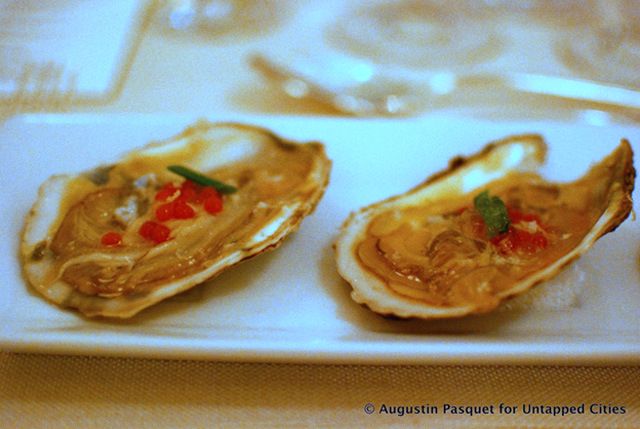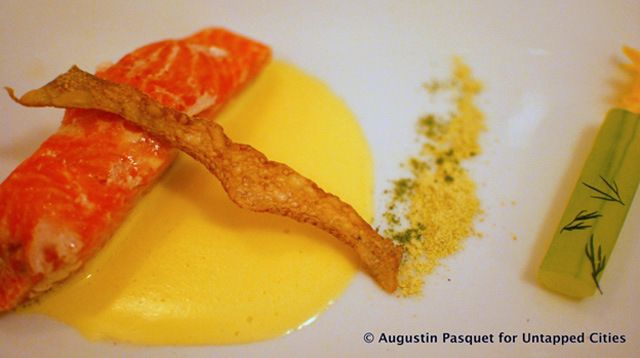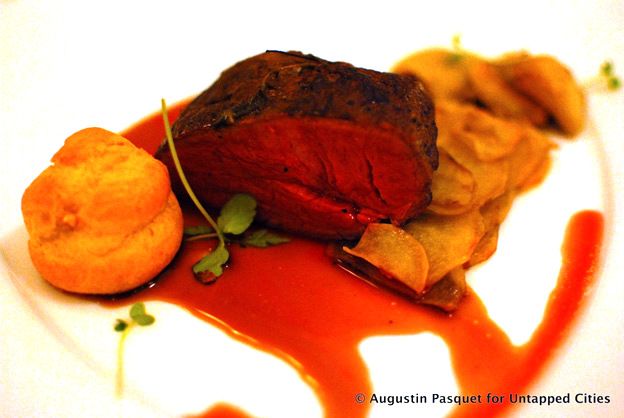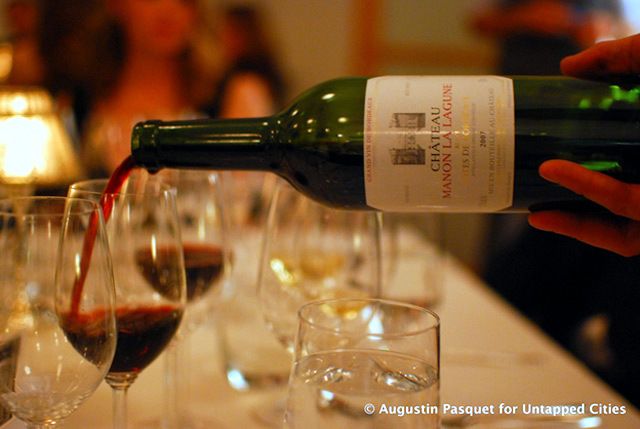Last Chance: The Annual Orchid Show Soars at the New York Botanical Garden
The vibrant colors of Mexico come to NYC for a unique Orchid Show at NYBG!


I sensed the gentle vibration in my ears and on the soles of my shoes. Yet I could not determine its source. Was it from the engines down below, signaling to me an earlier arrival in New York than expected?
The incandescent warmth against the cool, white, graceful columns of the vast dining room and the elegance of the genteel men and women in their finery reassured my eyes that all was well; a glass of 40-year tawny port similarly reassured my spirit. Yet the expressions on everyone’s faces”¦the uncanny look that somehow everything that we were doing was scripted”¦that it all happened before”¦that we knew what awaited us at the end of this delightful night.
An unfamiliar music that echoed in the hall brought me to my senses. The vibrations came neither from gargantuan pistons and crankshafts roaring like primeval beasts far below us–nor did they come from that mountain of ice that had signaled the end–rather it had come from a crowded “N” train as it rumbled its way into the station of Union Square. Violently pulled from the depths of an induced nostalgia, I soon realized that we were no longer in 1912, but instead a hundred years into the present. It was April 14, 2012.

This induced nostalgia was a mark of success to the marvelous extravagance that had been orchestrated by Jonathan Cristaldi and Chefs Rob McCue and Adam Banks, our lead players in this danse macabre that memorialized the sinking of the R.M.S. Titanic so long ago. Few details of the period had been omitted, thus causing the feeling of transportation to another era; yet exceptional care had been taken to remind the audience of the reinterpretive nature of this gastronomic adventure. However, with dozens of recreations of the final dinner served that evening at long linen covered tables around the world, we could not say that our venture into that bygone era of wealth was unaccompanied. Fortunately, with the creative and collaborative genius of a young team that makes a point of assembling only the finest materials that the culinary world has to offer, this first-class ticket to yesteryear was surely the most unique.
Taking his inspiration from our collective fantasies of time-travel, Cristaldi, the evening’s producer who also brought the city such memorable event as the infamous “L-Train Luncheon,” went to great lengths in creating the experience. With an air of Edwardian theatricality, we were given a mysterious invitation that instructed us diners to meet a girl with a yellow flower in her hair on the northwest corner of 18th and Broadway. The carefully calculated recalibration to an alternative reality had begun.

From the Dining Saloon:
Ascending the three floors to our dining space perhaps did not seem to most like a dramatic experience, but the exiting of the elevator car into an airy room filled with the sounds of cheerful chatter and the clinking of glasses could not be described in any way other than transcendent. Though one felt as if they were suddenly transported to another era, we were gently reminded by the musicians that we were not entering the over-complicated age of our forebears. Replacing the waltzes of Archibold Joyce and operatic excerpts of Offenbach were the contemporary and entrancing strains of fine Brooklynite musicians such as Chrome Canyon (featuring Icky Doom of Shad[]wb[]x on that delightfully infernal device known to us modern men as the “computer”) and Megan Sears on that more civilized and patrician instrument, the cello.
Over glasses of period cocktails and fine scotch (Glenmorangie was among the sponsors), women clad in long silk shawls laughed alongside gentlemen in full evening attire. Despite the morbid nature inherent to this commemorative event — a fact not lost on our respectful hosts who called for a moment of silence at the hour that our fateful ship struck the iceberg in the frigid waters of the North Atlantic — happiness prevailed. This was perhaps the greatest success of the evening, and a goal fulfilled for the event’s organizers. The transmundane ambience of the dining room benefitted not from the gloom that accompanies a wake or funeral, but rather from the gaiety of the diners who, much like the historical individuals that they were standing in for, likely did not have a care in the world as they sailed toward their as-of-yet unknown fate. It was a tribute to how this cosmopolitan class once lived, not perished.
From the Galley:
To best understand how this group of people enjoyed life, it was paramount to understand how they ate. From the kitchen, those epicureans of renown, Banks, from Bravo’s Chef Roble & Co. and McCue, from Fox’s Hell’s Kitchen, had conjured up the lucullan feast that will for many years be remembered by those who attended. Their story began many weeks before, in the tireless and often suspenseful moments of preparation. With a mission to ensure that the nostalgic palates of the time voyagers would encounter all of the same elements that had been savored that fateful evening a century ago, they went to extreme lengths to procure the numerous delicacies that were present that evening.
 (left) Chefs Adam Banks, Roble Ali and Rob McCue in preparation at the International Culinary Center (ICC)
(left) Chefs Adam Banks, Roble Ali and Rob McCue in preparation at the International Culinary Center (ICC)
Take for example, the ingredients of the soup course. Consommé Olga, an Escoffier standard, required a near impossible-to-find ingredient — vesiga, the dried spinal marrow of the European sturgeon. It was originally served at a time when this delicacy of the Imperial Russian nobility was an expensive though not particularly unobtainable commodity in the world of haute cuisine. Lamentably, this is no longer the case. Frantic emails were sent, endless phone calls were made, and translators were even brought in to scour the markets of Brighton Beach and contact exporters from as far away as the Ukraine. At the eleventh hour, a whole sturgeon was located. Granted, it wasn’t exactly what they were looking for, but it had what they needed. I saw the disassembled carcass of the noble fish, bearer of the millionaire’s delight — beluga caviar. Yet there was to be no royal roe at this last great feast. Rather than proffer up its unborn offspring, it instead gave us something far more vital to its physical structure — its backbone. By the culinary fiat of our masters of the kitchen, there was vesiga, boiled and gelatined to the consistency that would have been familiar to Astor or Boyar alike.

With the attention to compositional authenticity, it must be stressed that this was no mere simplistic recreation of the now seemingly ancient dishes that were served that night. Savvy to the sophistication of the first class passengers of that distant belle époque and their tireless pursuit to live à la mode, our masters of the kitchen ensured that nothing would be sent to the tables unless transformed in a manner suitable to the similar standards that the first class gastronomes of today have come to expect.
Emblematic of such creative transformations was the Oyster course. Though likely served plain and on ice that fateful evening so long ago, our masters of the kitchen followed the direction that many Titanic dinners have taken with the release of Rick Archbold and Dana McCauley’s book Last Dinner on the Titanic and served them à la russe. Unsatisfied with the classical convention of merely serving them in the vodka-tomato sauce that was likened to a Bloody Mary by one of our chefs, they decided to bring this dish into the 21st century. Restructuring the uninspiring relish was an act of art for these men. Seeking a solution that satisfied our modern aesthetic tastes, they created fiery bright red pearls of vodka, tomato, citrus and horseradish to adorn the freshly shucked bivalves. The effect upon the slightly opaque flesh of the sea creature and the gently nacreous shell was perhaps more likeable to a piece of baroque jewelry.



From the Cellar:
To complement the evening’s sumptuous feast, Jennifer Simonetti-Bryan, Master of Wine, along with our ever modest Jonathan Cristaldi, a self-proclaimed “Wine-prophet” and creator of The Noble Rot, a travelling wine saloon, brought some of the finest vintages to the table. Both of them had spent many a long night over a bottle discussing the perfect pairings and making sure that all the wine brands used that evening were in existence prior to 1912.

Beginning the evening with bottles off Laurent-Perrier, a champagne of “avant-garde” strain for the evening, though of the period, was a signal of the pleasant things to come. Bottle after bottle brought one or another unique flavor to the table, culminating perhaps with a perfect combination for the heart of the classical French meal. The deep red wine that was paired with the entrée (an exquisite Fillet Mignon Lili that could best be described as a tender piece of heavenly paradise served with flavorful fresh artichoke hearts and a fois gras that melted in one’s mouth) was of a noble and ancient nature — a Bordeaux that tasted as if it had been brought up from the depths of the choppy Atlantic waters that consumed our ship so long ago. Perhaps inebriating us like a fantastic spell, the wines continued to blur the past and present as the evening progressed — an excellent feeling to compliment the similar blur of taste and time inherent to the foods served that evening.

At the end of the evening, all of our senses had been stimulated to a near ecstatic level — open laughter and lively discussion over ports and cognacs were signaling that the grand ceremony of the feast was drawing to its conclusion. A gentle vibration could once again be felt beneath us — a Proustian moment that conjured up memories for an event that none of us had lived through. It perhaps evoked that gentle sensation that woke up few and could only be felt by the group of men that played cards and drank cordials in the smoking room of that ill-fated vessel. There was no sight of an iceberg rapidly passing by the windows that instead looked down on the busy traffic of Broadway. It was once again the New York Subway, reminding this writer that a departure from the world of reinterpretive nostalgia was imminent. Strolling along with my photographer to Union Square, the both of us in formal evening clothes, we were certainly quite the sight. At the conclusion of our cigars in the park, it was nearing two o’clock in the morning, close to the time that our liner disappeared beneath the icy waters one-hundred years ago. Time flew so quickly with seven courses and seven wines in the stomach — indeed, how little time, it now seemed, the original diners of the Titanic must have had to grasp the full scope of what was to occur. The dinner was over, and the profundity of the anniversary had suddenly arrested me. Yet whatever sorrowful mourning that should have been performed at this commemoration could have never seemed more inappropriate. For why should we have remembered the lives lost by recalling the tragic moments of their demise? Rather, to live as they lived, at least for a brief moment, was perhaps the most appropriate tribute.
Subscribe to our newsletter